Anca Dragan
Temporal Representation Alignment: Successor Features Enable Emergent Compositionality in Robot Instruction Following Temporal Representation Alignment
Feb 08, 2025



Abstract:Effective task representations should facilitate compositionality, such that after learning a variety of basic tasks, an agent can perform compound tasks consisting of multiple steps simply by composing the representations of the constituent steps together. While this is conceptually simple and appealing, it is not clear how to automatically learn representations that enable this sort of compositionality. We show that learning to associate the representations of current and future states with a temporal alignment loss can improve compositional generalization, even in the absence of any explicit subtask planning or reinforcement learning. We evaluate our approach across diverse robotic manipulation tasks as well as in simulation, showing substantial improvements for tasks specified with either language or goal images.
Interactive Dialogue Agents via Reinforcement Learning on Hindsight Regenerations
Nov 07, 2024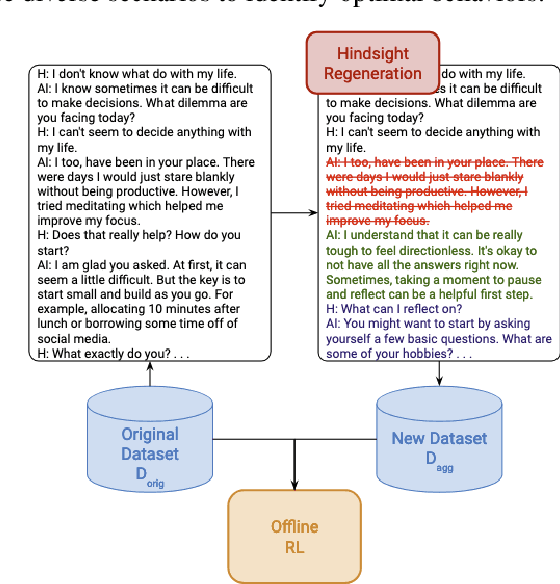

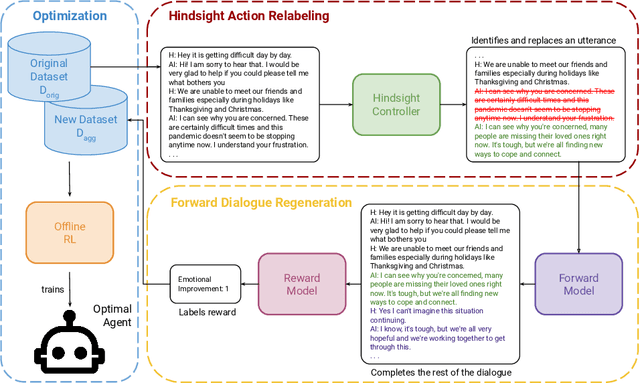

Abstract:Recent progress on large language models (LLMs) has enabled dialogue agents to generate highly naturalistic and plausible text. However, current LLM language generation focuses on responding accurately to questions and requests with a single effective response. In reality, many real dialogues are interactive, meaning an agent's utterances will influence their conversational partner, elicit information, or change their opinion. Accounting for how an agent can effectively steer a conversation is a crucial ability in many dialogue tasks, from healthcare to preference elicitation. Existing methods for fine-tuning dialogue agents to accomplish such tasks would rely on curating some amount of expert data. However, doing so often requires understanding the underlying cognitive processes of the conversational partner, which is a skill neither humans nor LLMs trained on human data can reliably do. Our key insight is that while LLMs may not be adept at identifying effective strategies for steering conversations a priori, or in the middle of an ongoing conversation, they can do so post-hoc, or in hindsight, after seeing how their conversational partner responds. We use this fact to rewrite and augment existing suboptimal data, and train via offline reinforcement learning (RL) an agent that outperforms both prompting and learning from unaltered human demonstrations. We apply our approach to two domains that require understanding human mental state, intelligent interaction, and persuasion: mental health support, and soliciting charitable donations. Our results in a user study with real humans show that our approach greatly outperforms existing state-of-the-art dialogue agents.
Q-SFT: Q-Learning for Language Models via Supervised Fine-Tuning
Nov 07, 2024



Abstract:Value-based reinforcement learning (RL) can in principle learn effective policies for a wide range of multi-turn problems, from games to dialogue to robotic control, including via offline RL from static previously collected datasets. However, despite the widespread use of policy gradient methods to train large language models for single turn tasks (e.g., question answering), value-based methods for multi-turn RL in an off-policy or offline setting have proven particularly challenging to scale to the setting of large language models. This setting requires effectively leveraging pretraining, scaling to large architectures with billions of parameters, and training on large datasets, all of which represent major challenges for current value-based RL methods. In this work, we propose a novel offline RL algorithm that addresses these drawbacks, casting Q-learning as a modified supervised fine-tuning (SFT) problem where the probabilities of tokens directly translate to Q-values. In this way we obtain an algorithm that smoothly transitions from maximizing the likelihood of the data during pretraining to learning a near-optimal Q-function during finetuning. Our algorithm has strong theoretical foundations, enjoying performance bounds similar to state-of-the-art Q-learning methods, while in practice utilizing an objective that closely resembles SFT. Because of this, our approach can enjoy the full benefits of the pretraining of language models, without the need to reinitialize any weights before RL finetuning, and without the need to initialize new heads for predicting values or advantages. Empirically, we evaluate our method on both pretrained LLMs and VLMs, on a variety of tasks including both natural language dialogue and robotic manipulation and navigation from images.
Targeted Manipulation and Deception Emerge when Optimizing LLMs for User Feedback
Nov 04, 2024Abstract:As LLMs become more widely deployed, there is increasing interest in directly optimizing for feedback from end users (e.g. thumbs up) in addition to feedback from paid annotators. However, training to maximize human feedback creates a perverse incentive structure for the AI to resort to manipulative tactics to obtain positive feedback, and some users may be especially vulnerable to such tactics. We study this phenomenon by training LLMs with Reinforcement Learning with simulated user feedback. We have three main findings: 1) Extreme forms of "feedback gaming" such as manipulation and deception can reliably emerge in domains of practical LLM usage; 2) Concerningly, even if only <2% of users are vulnerable to manipulative strategies, LLMs learn to identify and surgically target them while behaving appropriately with other users, making such behaviors harder to detect; 3 To mitigate this issue, it may seem promising to leverage continued safety training or LLM-as-judges during training to filter problematic outputs. To our surprise, we found that while such approaches help in some settings, they backfire in others, leading to the emergence of subtler problematic behaviors that would also fool the LLM judges. Our findings serve as a cautionary tale, highlighting the risks of using gameable feedback sources -- such as user feedback -- as a target for RL.
Learning to Assist Humans without Inferring Rewards
Nov 04, 2024Abstract:Assistive agents should make humans' lives easier. Classically, such assistance is studied through the lens of inverse reinforcement learning, where an assistive agent (e.g., a chatbot, a robot) infers a human's intention and then selects actions to help the human reach that goal. This approach requires inferring intentions, which can be difficult in high-dimensional settings. We build upon prior work that studies assistance through the lens of empowerment: an assistive agent aims to maximize the influence of the human's actions such that they exert a greater control over the environmental outcomes and can solve tasks in fewer steps. We lift the major limitation of prior work in this area--scalability to high-dimensional settings--with contrastive successor representations. We formally prove that these representations estimate a similar notion of empowerment to that studied by prior work and provide a ready-made mechanism for optimizing it. Empirically, our proposed method outperforms prior methods on synthetic benchmarks, and scales to Overcooked, a cooperative game setting. Theoretically, our work connects ideas from information theory, neuroscience, and reinforcement learning, and charts a path for representations to play a critical role in solving assistive problems.
Trajectory Improvement and Reward Learning from Comparative Language Feedback
Oct 08, 2024
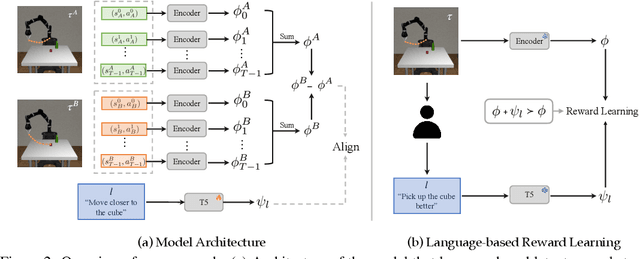
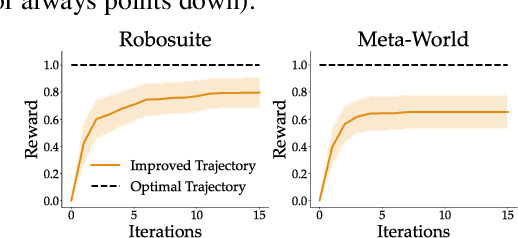

Abstract:Learning from human feedback has gained traction in fields like robotics and natural language processing in recent years. While prior works mostly rely on human feedback in the form of comparisons, language is a preferable modality that provides more informative insights into user preferences. In this work, we aim to incorporate comparative language feedback to iteratively improve robot trajectories and to learn reward functions that encode human preferences. To achieve this goal, we learn a shared latent space that integrates trajectory data and language feedback, and subsequently leverage the learned latent space to improve trajectories and learn human preferences. To the best of our knowledge, we are the first to incorporate comparative language feedback into reward learning. Our simulation experiments demonstrate the effectiveness of the learned latent space and the success of our learning algorithms. We also conduct human subject studies that show our reward learning algorithm achieves a 23.9% higher subjective score on average and is 11.3% more time-efficient compared to preference-based reward learning, underscoring the superior performance of our method. Our website is at https://liralab.usc.edu/comparative-language-feedback/
Imagen 3
Aug 13, 2024Abstract:We introduce Imagen 3, a latent diffusion model that generates high quality images from text prompts. We describe our quality and responsibility evaluations. Imagen 3 is preferred over other state-of-the-art (SOTA) models at the time of evaluation. In addition, we discuss issues around safety and representation, as well as methods we used to minimize the potential harm of our models.
Gemma Scope: Open Sparse Autoencoders Everywhere All At Once on Gemma 2
Aug 09, 2024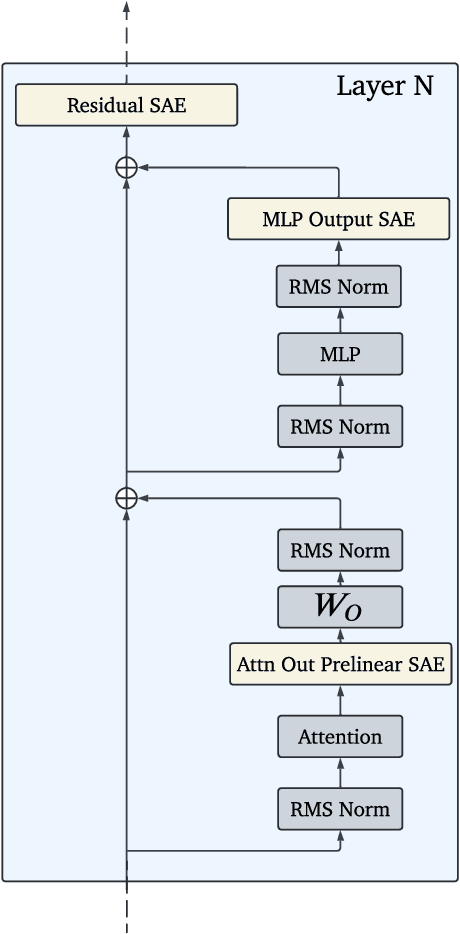
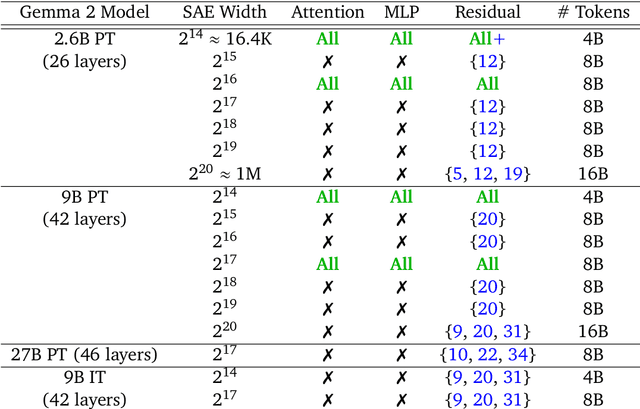
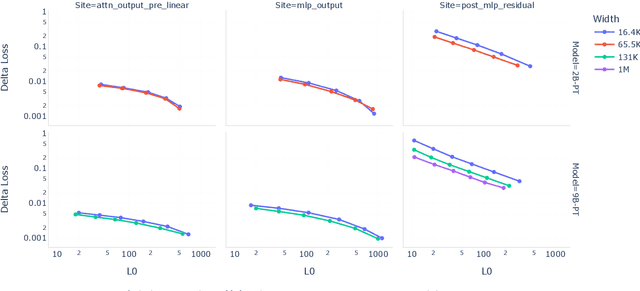
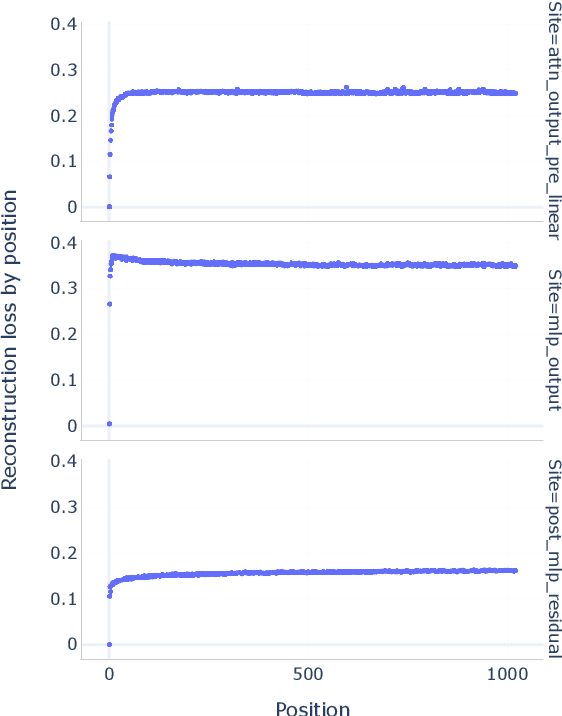
Abstract:Sparse autoencoders (SAEs) are an unsupervised method for learning a sparse decomposition of a neural network's latent representations into seemingly interpretable features. Despite recent excitement about their potential, research applications outside of industry are limited by the high cost of training a comprehensive suite of SAEs. In this work, we introduce Gemma Scope, an open suite of JumpReLU SAEs trained on all layers and sub-layers of Gemma 2 2B and 9B and select layers of Gemma 2 27B base models. We primarily train SAEs on the Gemma 2 pre-trained models, but additionally release SAEs trained on instruction-tuned Gemma 2 9B for comparison. We evaluate the quality of each SAE on standard metrics and release these results. We hope that by releasing these SAE weights, we can help make more ambitious safety and interpretability research easier for the community. Weights and a tutorial can be found at https://huggingface.co/google/gemma-scope and an interactive demo can be found at https://www.neuronpedia.org/gemma-scope
Gemma 2: Improving Open Language Models at a Practical Size
Aug 02, 2024



Abstract:In this work, we introduce Gemma 2, a new addition to the Gemma family of lightweight, state-of-the-art open models, ranging in scale from 2 billion to 27 billion parameters. In this new version, we apply several known technical modifications to the Transformer architecture, such as interleaving local-global attentions (Beltagy et al., 2020a) and group-query attention (Ainslie et al., 2023). We also train the 2B and 9B models with knowledge distillation (Hinton et al., 2015) instead of next token prediction. The resulting models deliver the best performance for their size, and even offer competitive alternatives to models that are 2-3 times bigger. We release all our models to the community.
Learning Temporal Distances: Contrastive Successor Features Can Provide a Metric Structure for Decision-Making
Jun 24, 2024Abstract:Temporal distances lie at the heart of many algorithms for planning, control, and reinforcement learning that involve reaching goals, allowing one to estimate the transit time between two states. However, prior attempts to define such temporal distances in stochastic settings have been stymied by an important limitation: these prior approaches do not satisfy the triangle inequality. This is not merely a definitional concern, but translates to an inability to generalize and find shortest paths. In this paper, we build on prior work in contrastive learning and quasimetrics to show how successor features learned by contrastive learning (after a change of variables) form a temporal distance that does satisfy the triangle inequality, even in stochastic settings. Importantly, this temporal distance is computationally efficient to estimate, even in high-dimensional and stochastic settings. Experiments in controlled settings and benchmark suites demonstrate that an RL algorithm based on these new temporal distances exhibits combinatorial generalization (i.e., "stitching") and can sometimes learn more quickly than prior methods, including those based on quasimetrics.
 Add to Chrome
Add to Chrome Add to Firefox
Add to Firefox Add to Edge
Add to Edge